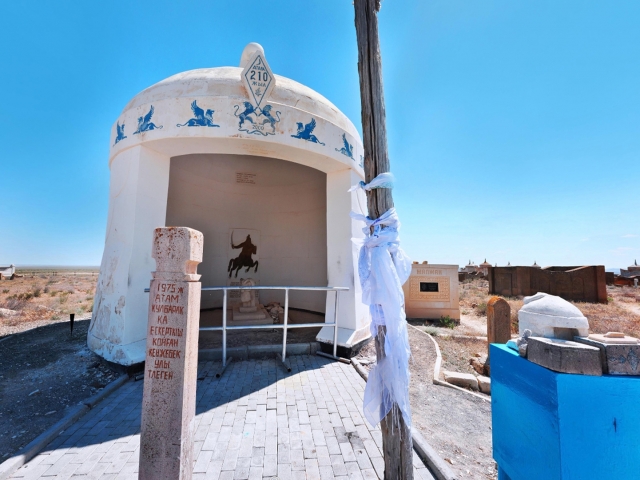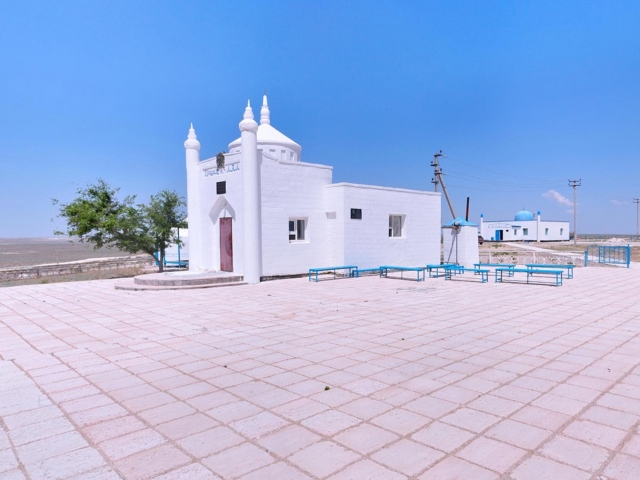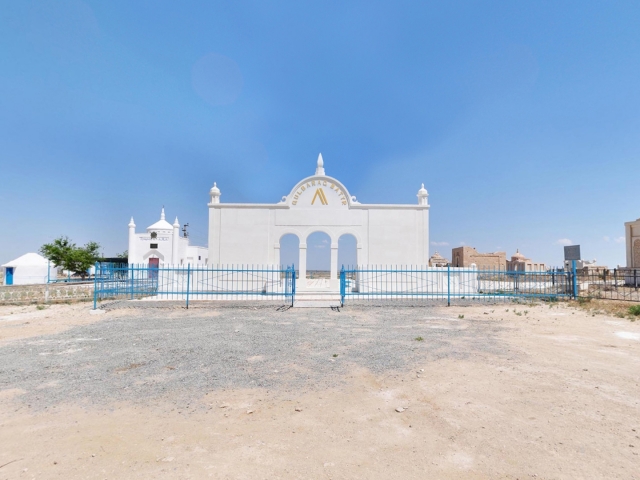Places
List of objects included in the map
Kulbarak Batyr Mausoleum
Location: located in Mangistau district of Mangistau region, 36 km to the north from Shetpe village.
Coordinates: N 44°26' 50.10", E 52° 8' 32.45"
Description of the Monument: The monument was first taken under governmental protection by Decision of Mangyshlak Executive Committee of the Regional Council of people's deputies no. 496 dated 24.10.1987. It is currently included in the list of national historical and cultural monuments of local value upon Order no. 279 dated July 28, 2010 by Mangystau Regional Akimat .
In 1984 expedition of Mangyshlakrestavratsiya under the direction of O. P. Ryagusova carried out the works. At the necropolis there are over a hundred and fifty structures referring to different time and kind. The necropolis stretches from the north to the south. There is a vast majority are saganatam. In the necropolis there are two domed mausoleums in the western and in the southern parts of the necropolis. In the central part of the necropolis there are kulpytasses and koitasses. Kulpytasses have simple shapes with pointed end. Judging by the location of the monuments, the main development of the necropolis was in the 20th century. Monuments are decorated with plane, contour carving colored blue, turquoise and red.
Historical Data, Legends and Stories: Aulie Kulbarak-batyr (1790-1832) from Berish tribe (Karatokai subtribe) was born in Mangistau. There are two burials of Kulbarak-batyr: the first one in Khiva, in mausoleum of Mahmut-paluan; the second one is Kulbarak necropolis where the batyr's body is resting. In the 30-ies of the 19th century a battle began between the Kazakhs and the Turkmens of Khiva (i.e. Adais are Zhaumits); Suyunkar-batyr's aul in the area Buzachi-Kabakty was destroyed the warriors of the khan of Khiva Allakul headed by the vizier Suyunpushik. Kazakh batyrs overtook them and in the area of Karnau a great battle took place. In his epic Abyl-akyn waxed eloquent on this Karnau battle in Kyrgynsai area. Upon the order of khan Allakul Turkmens had to bring the head of Suyunkai batyr, but they had mixed Kulbarak and Suyunkara and brought the head of Suyunkara to Kulbarak batyr. The legend says that the head of Kulbarak grinned at khan Allakul. Both these burials are visited by pilgrims. Historical data about the honored and revered batyr can be found in writings of word wizards – poets Abiyl, Murat Monkeuly, that have survived to our time. In the necropolis, where Kulbarak-batyr lies there also are the tombs of Kussana-auliye, Bekzhan-auliye, where shirak is also kindled (animal fat the odor of which fills the souls of the dead, according to the belief). Today there is a pilgrim overnight house here. In 1991 the descendants of Berish-Ata built a large mosque and put up a memorial plaque. Upon the initiative of Tilegen Kenzhebekuly in 2000 in celebration of 210 years from the date of birth of Kulbarak-batyr a white contemporary mausoleum in the form of a helmet was constructed. The author of the monument is sculptor Abish Kenzhebayev. Kulbarak-batyr is a hero, holy person and a multifaceted personality who defended the country during the enemy attack. Today the heroic act of the batyr is passed down for generations as an example of courage and heroism. Therefore legends and stories told by the people are valuable asset.
Sources:
- 'Holy Places of Mangistau
and Ustyurt' Serikbol Kondybay, 2007.
- Archives
of Mangistau National Historical and Cultural Reserve.
Views: 3835
Video
Маршрут
Hazret Yerzhan Burial
Shopan Ata Necropolis and Underground Mosque
Shakpak Ata Necropolis and Underground Mosque (14th–19th centuries)
Khatam-Ishan Mausoleum
The earliest structures here date back to the second half of the 17th c. The necropolis was developed in time and space in a circle, i.e. the most ancient constructions remained in the center. Out of the two extant domed mausoleums, the structure in the southern part of the necropolis is of particular interest. ...













